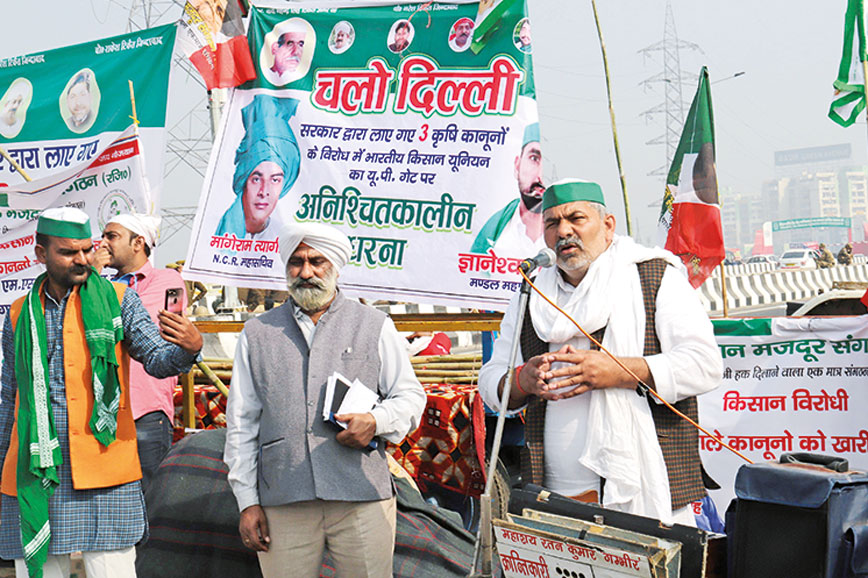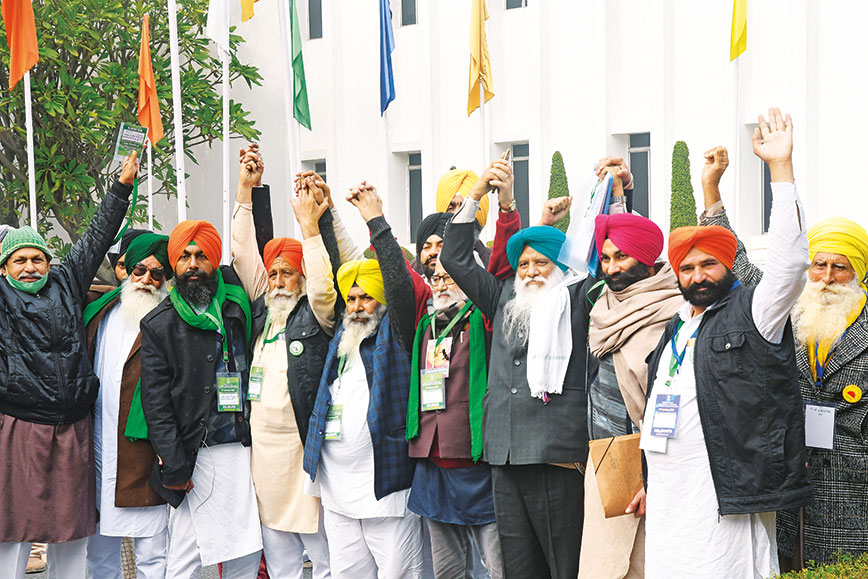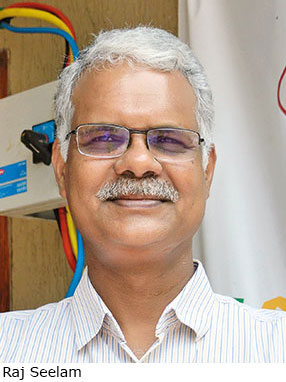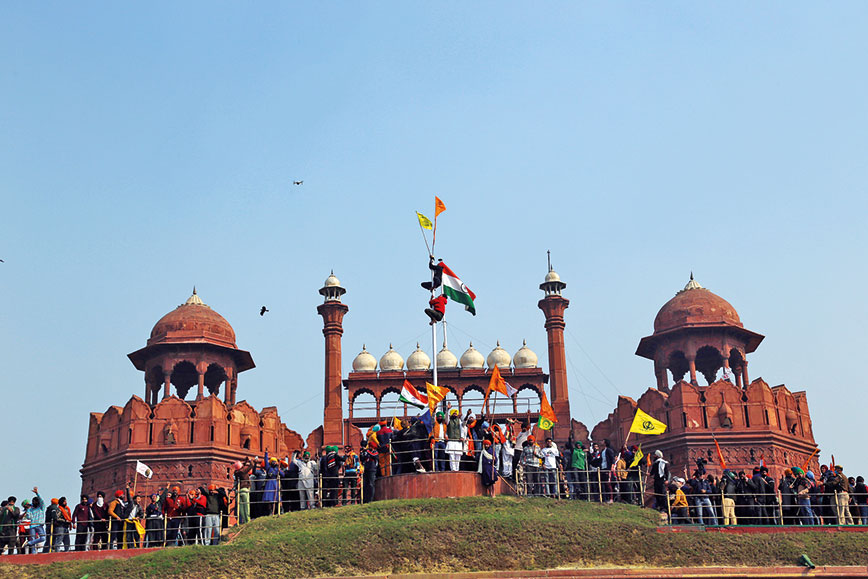
Farmers at the Singhu border
Why farmers won't budge and the real story of reforms
Civil Society News, New Delhi
WHEN three laws aimed at improving farm incomes were speeded through Parliament in September last year, a chorus of headlines hailed them as being signal pieces of legislation that had the potential to transform Indian agriculture by attracting private investment and linking farmers to new markets.
Farmers in Punjab and Haryana, however, thought differently and when they felt that their protests in their villages were not getting the attention of the Bharatiya Janata Party (BJP) government at the Centre, they began a long march to Delhi.
Camping on the borders of the capital, they made their own headlines by denouncing the farm laws and accusing the government of seeking to corporatize farming in collusion with big business.
For around 60 days, during which leaders of farmer unions held talks with the government, the protest remained peaceful though it involved tens of thousands of people from villages.
Then on January 26, a decision to take out a parade of their own to mark Republic Day, ended in a fiasco for the farmers. Rogue elements defied farmer union leaders, entered Delhi on tractors and perpetrated violence. They occupied Red Fort and hoisted a flag of their own.
As Civil Society went to press, there was a high alert in Punjab and Delhi and its surrounding national capital region. It was not clear which way matters would go. It seemed the farmers had, with this turn of events, lost some of the goodwill they had gained across the country with their resolute sit-in in difficult circumstances.
The issues, however, remain the same. The farmers are concerned that with the new laws the minimum support price (MSP) for crops, particularly wheat and rice, will get abolished over time in favour of a free market in which the government will have no role in setting a floor price. They are also fearful of being pushed off their lands because of the expanding influence of corporations and the view taken by liberalizers that only very big landholdings make commercial sense.
Punjab has its better-off farmers who benefit from the MSP. At the same time 70 percent of the small and marginal farmers in the state also depend on the MSP. Though liberalizers would want landholdings to be consolidated, people depend on their small plots in the absence of employment opportunities and social security.
Economic reforms tend to run into opposition from entrenched stakeholders. But never before perhaps has the gulf between India’s liberalizers and ordinary people been so dramatically visible. Nor has the distrust of business houses like Adani and Reliance been so openly voiced. Significantly, though farmers in Punjab took the lead, they soon found support from Haryana, Rajasthan, Uttar Pradesh, Uttarakhand and farmers in other states across the country, some of whom actually turned up to join the protests.
At the heart of this high-voltage confrontation is the urgent need to make Indian agriculture more sustainable. Small landholdings, falling incomes, poor infrastructure and environmental stress have piled up as issues that must be addressed.
Everyone agrees that solutions are overdue. Farmers should be better integrated with markets and given a bigger share of the final price of their produce. The question is what are the reforms that will work for everyone in a uniquely Indian context.
Is the MSP the magic answer or is it a socialistic relic, a burden on the exchequer and a distortion of market realities? Will replacing the MSP and opening up the farm sector in general bring farmers up or will it place them at the mercy of business interests in unequal commercial relationships?
 Rakesh Tikait, leader of the Bharatiya Kisan Union, addresses farmers
Rakesh Tikait, leader of the Bharatiya Kisan Union, addresses farmers
Currently, only a small percentage of farmers across India get the MSP. It applies to 23 crops, but it is for wheat and rice that MSP is given in a significant way. In many states, many of the transactions already happen outside mandis or government-designated markets where no MSP applies. So, market forces are at work. But prices for farm produce have been declining and agriculture is a loss-making enterprise. In poor states like Jharkhand farmers sell their crops much below the MSP. Poverty, debt and suicide are pervasive in Punjab too.
Globally, subsidies remain the norm because integrating farmers to free markets hasn’t ensured better incomes for them. Can the MSP be used as a form of subsidy which can bring competition, regulation and better prices? It is being argued that instead of retreating, the government should increase its presence with a bigger network of well-regulated points of sale where the MSP becomes the base price.
THE THREE LAWS
The three laws that have brought farmers onto highways are the Farmers’ Produce Trade and Commerce (Promotion and Facilitation) Act, the Farmers’ (Empowerment and Protection) Agreement of Price Assurance and Farm Services Act and the Essential Commodities (Amendment) Act.
Taken together, these laws seek to change the way business is done with the avowed intention of getting better prices for farmers.
Farmers will be allowed to sell their produce both at state government-managed mandis or wholesale markets under the Agriculture Produce Market Committees (APMCs) and at private mandis set up by companies. The MSP at government mandis is not being done away with but private mandis would have the advantage of not being taxed.
Farmers can also get into contract farming arrangements with companies and market their produce wherever they want to. Commodities like cereals, pulses, oilseeds, edible oils, onions and potatoes have been removed from the list of essential commodities. This means companies and traders can stock as much of such commodities as they want, ‘except under extraordinary circumstances’.
There are 41 farmer unions protesting against the laws. They say initially it will be cheaper to transact in private markets since the mandi fee has been waived. Companies too will offer better prices. But over time the government-run mandi will wither away and together with it will go the MSP and purchases by the government at assured prices. Their fear is that farmers will finally be left at the mercy of companies and sundry private traders who will drive down prices.
On the 48th day of the agitation, the Supreme Court intervened to suspend the operation of the laws and appoint a committee to find a solution. The farmers rejected the committee, saying its members were all pro-government and known supporters of the laws. A farmer union leader who was appointed to the committee quit the next day.

‘MARKET HASN’T WORKED’
“Reforms are long overdue. The question is what kind of reforms,” says Devinder Sharma, an insightful food and agriculture researcher based in Punjab and an insider to the farmer unions.
Sharma questions the thesis that free markets raise the incomes of agriculturists. The market hasn’t worked to do this even in the most developed of economies where farmers are heavily subsidized. How can the market be expected to deliver better incomes to Indian farmers, he asks.
“The market reforms that are being planned are based on the American model. But in America farming is a declining occupation and billions of dollars are given to American farmers by way of subsidies so that they can survive,” says Sharma.
He is well armed with his figures and says: “A report by the Centre for WTO Studies shows that on average a farmer in America gets a subsidy of $62,000 every year whereas an Indian farmer gets just $282.”
Sharma argues that despite full access to free markets, America’s farmers are saddled with $425 billion in bankruptcies. There is no MSP, APMC or mandi in America. They have big retail chains like Walmart which have no stock limits, there is contract farming and commodity trading, the biggest one being in Chicago. Farmers are literate and have computers. And yet markets haven’t worked for them.
BIG AND SMALL
Regarding the argument that small holdings in India are unviable, Sharma asks for evidence that larger holdings will be better. Merely pushing small farmers out of agriculture when they have no alternative to fall back on is not the answer, he says.
“The American model requires the farmer to get big or get out. But if size were the crucial thing why isn’t the American farmer with an average landholding of 400 acres successful?” he asks.
Sharma argues that the problem lies in an economic model in which corporations drive down costs to increase their profits. It results in farmers getting a mere fraction of the end price of their produce. In America, out of every dollar a consumer spends, the farmer’s share is just eight cents.
Similarly, cocoa farmers in western Africa or Latin America earn just `100 or $1.3 per day. This from a $210 billion global chocolates and confectionery industry. “The bigger companies rake in the profits,” he says.
And despite the rising café culture, coffee in India faces a crisis. “Coffee farmers have a `8,000 crore debt they want written off and they are asking for an MSP for coffee,” says Sharma.
The reason why markets don’t work for farmers, making it necessary to bestow subsidies on them, is that the value chain is actually built on extracting cheap raw material from the primary producer, who is the farmer.
MORE MANDIS NEEDED
In the current agitation, the sticking point has been the MSP that farmers get at government-run mandis. They want the MSP to be mandated by law. The worry for them is that by setting up private mandis under the new law, the government-run mandi is essentially being bypassed. The farmers see this as the first stage in doing away with MSP.
 Leaders of farmer unions show solidarity before a meeting with government officials
Leaders of farmer unions show solidarity before a meeting with government officials
The regulated mandi, the MSP, and procurement by the Food Corporation of India (FCI) have worked well in Punjab and Haryana. The average income of the north Indian farmer is higher than that of farmers elsewhere in the country. "The average earning of a farming family in 17 states of India, as reported in the Economic Survey 2016, is only `20,000 a year or `1,700 a month. I shudder to think how they lived on that meagre income," says Sharma.
There is a strong case for strengthening mandis through better regulation and increasing their number so that farmers have access to organized and supervised markets closer to their fields.
“We have 1,800 mandis in Punjab. The government has invested massively in building roads that link farms to mandis. About 70,000 km of village link roads exist in Punjab. That’s the kind of model that should be replicated across the country,” says Sharma. “Across India we have 7,000 regulated mandis. What we need are 42,000 mandis in a five-km radius. This is a public sector investment. We haven’t done it because a class of economists wanted it left to the private sector,” Sharma alleges.
He further argues that if economists say that markets will give higher prices to farmers, the prices have to be higher than something. There has to be a benchmark price and that is the MSP. So, why not support the demand for an MSP. “The MSP should be made legal for 23 crops. These cover 80 percent of the gross cropped area in India so it will increase the income of a large section of the farming community. Rural demand will go up in a manner we have not seen which is just what the economy needs,” says Sharma.
He says that economists who take the position that the government does not have the money are fear mongering. He cites Kerala as an example. The state fixes an MSP for 16 vegetables — cost of production plus 20 percent. It has set aside `35 crore to pay this MSP. But it hasn’t used a single paisa the past two months because market prices are higher than the MSP. “If the floor price goes up then trading happens at that level,” explains Sharma.
REAL COMPETITION
 Kavitha Kuruganti, convener of ASHA-Kisan Swaraj, one of the unions which is part of the agitation, cautions against fragmenting the market in the name of competition because then prices get beaten down. Much better, she says, to have a strong mandi system where an MSP assures farmers the best price.
Kavitha Kuruganti, convener of ASHA-Kisan Swaraj, one of the unions which is part of the agitation, cautions against fragmenting the market in the name of competition because then prices get beaten down. Much better, she says, to have a strong mandi system where an MSP assures farmers the best price.
“If the government really wanted competition it should have asked all big players, whether Adani or Reliance Fresh, to bid for the price they have to offer inside the mandi. That is competition,” she says.
The MSP was originally introduced to boost food production and allow farmers to concentrate on growing crops that the country needs — secure in the thought that the government will buy produce at an established price into which is factored their profit.
Dr M.S. Swaminathan, who is known as the father of the Green Revolution, in a landmark report submitted in 2004 proposed a single national market for farmers to get better prices, but he also suggested an MSP of cost of production plus 50 percent. Currently it is 20 percent.
Among liberalizers, the MSP is ridiculed. Dr Swaminathan, however, has interestingly described the MSP as being more efficient than subsidies. For farmers, the MSP helps them make ends meet.
FARMERS’ INCOMES
“When everyone in society has the expectation of an assured income, I can’t understand why we object when the farmer asks for an assured income,” says Sharma. “There is a study that shows farmers’ incomes have risen by just 19 percent in 45 years. In contrast, the basic pay and DA of government employees increased by 150 to 120 times, of university and college professors by 150 to 170 times and of schoolteachers by 200 to 300 times,” argues Sharma.
A study by OECD in 2018 with ICRIER revealed that from 2000 to 2016 Indian farmers lost `45 lakh crore. “If even a fraction of this had been lost by corporates there would have been a hungama over policy paralysis,” remarks Sharma.
 Mayhem on the streets of central Delhi on Republic Day
Mayhem on the streets of central Delhi on Republic Day
Falling farm incomes are a global phenomenon, says Sharma. A study by UNCTAD over a 20-year period, from the mid-1980s to the mid-2000s, said that globally the output price or farmgate price remained static during that period.
“The agitation in India is being closely watched by farmers’ groups all over the world and there is a lot of interest in how the MSP works here,” says Sharma.
STATES AND REFORMS
With its three laws, the centre has infringed on the domain of the states since agriculture is a state subject. Some states have already taken up such reforms. A lot of produce also sells outside the government mandi. In the southern states it could be as much as 60 percent.
Yet, there doesn’t seem to have been any attempt to study the experience of the states. Bihar, for instance, in 2006 did away with mandis, APMCs and MSP. Economists lauded the move and predicted the state would become a role model of market-led agriculture for the rest of India.
Instead, the reverse happened. No investments were made by companies and farmers get a paltry `1,000 to `1,200 per quintal for paddy whereas the farmer in Punjab is paid `1,800. The result is millions of people leave their unviable small farms in Bihar to work in cities, often for low wages, in terrible conditions.
“If Punjab can have a price delivery mechanism for farmers why can’t that MSP be given to farmers in Bihar?” asks Sharma.
MIX OF CROPS
Kuruganti argues that the MSP can be used as an incentive to grow the crops the country needs. For instance, if farmers in Punjab and Haryana are to be weaned away from growing rice and wheat, which are already in excess, an attractive MSP could nudge them in the direction of other crops.
“We believe that legal entitlement for all commodities will set right the equilibrium required for cropping patterns to be restored in India and help farmers shift from mono-cropping not only for paddy but also for wheat,” explains Kuruganti. “When assured prices exist which give farmers a small profit over and above cost of production, farmers will tend to pick up crops that are locally suitable and are environmentally sustainable,” she says.
The states are ideally suited to dealing with agriculture because agricultural production is diverse and so are markets based on commodities. Political and administrative responsibility should also ideally be local.
“Since 2003, a large majority of states has already incorporated many reforms in relation to private markets, direct marketing, electronic trading, contract farming and so on into their APMC Acts,” says Kuruganti. “It makes sense for the states to undertake reform. The central government doing it goes against the principle of good governance.”
In drawing up its three new laws, the centre did not take the states or farmers’ organizations into account. The lack of transparent consultation is the reason for the current distrust by farmers coming in the way of finding a solution to the agitation.
PRODUCER COMPANIES
Empowering farmers to do business is a challenge in itself. Growing their crops is one thing and selling them at a good price is quite another. There are problems of storage and finance. The real improvements in income are from value addition. The farmer has to be either helped to grow into such roles or learn to cultivate beneficial partnerships.
Liberalizers place much store on Producer Companies (PCs) in which farmers come together to do business and get a better price for their produce.
There are some 7,000 such entities in the country, but we learn from a study done by the Azim Premji University that they are severely under-capitalized and lacking in business expertise.
A growing number of PCs are being promoted by traders who have the networks and know the farmers they want to buy from. This goes against the very spirit of such organizations which are meant to serve as collectives through which farmers shape the transactions that are in their best interests.
The Azim Premji University study suggests a two-tier structure of supplier PCs and market-facing PCs. The supplier PCs should be shareholders in the market-facing PCs, which should serve as assured buyers and be equipped for sales, marketing, value addition and arbitrage so as to get the best prices.
 Ved Arya of Srijan, an NGO, says having entrepreneurial support is hugely beneficial for helping the farmer engage with the marketplace.
Ved Arya of Srijan, an NGO, says having entrepreneurial support is hugely beneficial for helping the farmer engage with the marketplace.
Srijan helps farmers organize themselves. But it isn’t enough because famers lack the savvy and expertise to engage commercially. So, Srijan has a Buddha Fellows programme under which it nurtures rural entrepreneurs who help farmers get better value for their produce.
Arya gives the example of custard apples, which are collected from forests and sold for as little as `2 a kg and then put into urban markets at several times that price.
Since custard apples are easily perishable, they get quickly offloaded to traders who know how to move them to the retail trade without damage.
A Buddha Fellow leveraged the opportunity in custard apples by removing the seeds and freezing the pulp which was then sold year-round to makers of natural ice-cream and to retail buyers as dessert.
Helping farmers improve their incomes mostly requires working closely with them. It involves handholding and long-term investments at field level. It is not the work governments can do themselves, but they can facilitate interventions by NGOs like Srijan and ethical companies that see value for themselves in upscaling farmers.
 24 Mantra, an organic food company, shows farmers how to make the shift to organic cultivation. It is a process which takes three years after which the company assists the farmers in getting certification as organic cultivators and then finally buys their produce.
24 Mantra, an organic food company, shows farmers how to make the shift to organic cultivation. It is a process which takes three years after which the company assists the farmers in getting certification as organic cultivators and then finally buys their produce.
Farmers who go organic get up to 20 percent more for their crops. 24 Mantra establishes a long-term relationship with them which goes much beyond the terms of a farming contract.
“The kind of contract we have is no more than a sheet long. What matters with the farmer is trust. Once the trust with the farmer is broken nothing can restore it,” says Raj Seelam, founder and chairman of 24 Mantra.
“The investment we as a company make is in supervision by our people and the cost of certification. Over the three years that the farmer is making the shift to organic cultivation he can continue to sell his produce in the market. After that the crop is picked up by us.”
Kuruganti, however, remains sceptical of how far contract farming will be beneficial for farmers. “For all of us, a farmer producer organization (FPO) is an empowering collective for greater bargaining space. Whereas, in the government’s concept, the FPO is that chamcha who will make the job of the company easier by aggregating individual marginal farmers. There is a part in the Contract Act called a production agreement which is akin to corporate farming where the risk is supposedly taken by the sponsor. It’s not as clean as it looks,” she says.
“The capacity of farmers to run FPOs or PCs is very limited,“ says Satyabrata Acharya of PRADAN, an NGO which works with a million small and marginal farmers in the poorer states of central and eastern India.
“The arthiya or trader is now getting into setting up FPOs and PCs using relatives, his own farm workers, clients he lends money to and so on. The big companies will buy through arthiyas and other middlemen,” says Acharya.“What sort of farming will be done, procurement and the crops to be grown, will be decided by companies through the arthiya. In Maharashtra and Madhya Pradesh we hear that large numbers of arthiyas are seeking to set up FPOs. It has now legitimized their position.”
“In hilly and tribal areas farmers are selling their paddy for `11 per kg, whereas the MSP is `19.62. They are not even recovering their cost of production," says Acharya. “In Jharkhand the rice is bought by traders, companies and rice mills. MSP makes no difference. Jharkhand does not have the system of mandis and government procurement that Punjab has.”
 Rogue elements overrun Red Fort on Republic Day
Rogue elements overrun Red Fort on Republic Day
One of the grievances against the new laws is that they were introduced in stealth and without discussion. It was probably a deliberate strategy, considering the complexities of the problems involved. But, as the current gritty agitation has shown, building a consensus that involves farmers and the states would perhaps give reforms a better chance of success.
Comments
-

M C Maniraj - June 2, 2021, 11:30 p.m.
Very educative article written with clarity on the crux of the farm issues
-

Shruti - Feb. 9, 2021, 3:22 p.m.
Very comprehensive article. Thanks for this. I now understand the reason for the mistrust amongst farmers regarding the laws that the government has made.
-

Anita Anand - Feb. 4, 2021, 11:29 a.m.
Great article. Well done.



